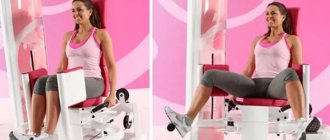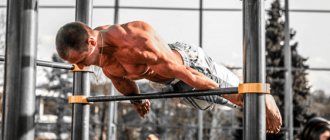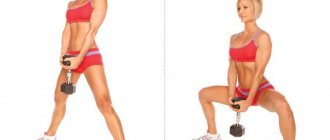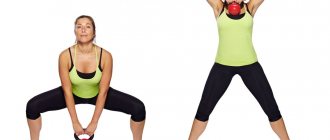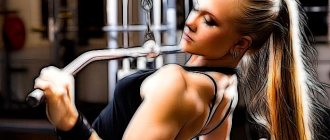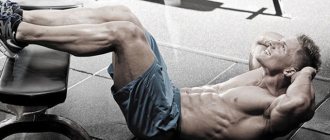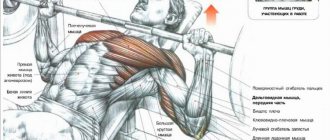The bench press is an effective exercise that develops strength and muscle mass in the shoulder and chest girdle. It gives a good load on the muscles of the core and abs, allowing you to form a beautiful relief. The bench press is a basic exercise that is used to train strength and endurance, allowing you to maximally work the pectoralis major muscle, triceps and anterior deltoids. Beginners should know the basic principles of the classic bench press, and those who have been training for a long time should check the correctness of the technique if the results are not noticeable.
Bench press mechanics - how to do it correctly
There are two main bench press techniques:
- bodybuilding;
- powerlifting
For bodybuilders, when pressing, the main load falls on the shoulder girdle for detailed development of the triceps, biceps, chest and anterior deltoids. In powerlifting, the load is distributed evenly to work the muscle mass of almost the entire body. Let's look at how to do the bench press correctly to work the right muscles.
Body position and preparation
The preparatory stage for the exercise is no less important than the process itself. Before lying on the bench, the athlete must check the stops and hooks and adjust the height. The bench should be located exactly in the middle relative to the barbell. Misalignment will result in incorrect balance. For maximum efficiency, the bench is located at a 30-degree incline. The bench press on a horizontal bench carries less load. It is difficult to lift a lot of weight on an incline, so for maximum results, trainers recommend alternating training on a flat and an incline bench.
Benching safety is a priority. Beginners are recommended to perform the exercise only with a spotter. It is located behind the headboard and helps you pick up and put down the barbell. During the entire press, it maintains the weight. The life and health of an athlete and his safety from injury may depend on it, so you should not neglect the help of an experienced athlete or coach.
Once the equipment and spotter are ready, it's time to get into the correct position on the bench. The athlete lies down so that the support points - head, lower back, shoulder blades and legs - feel the bench. If one or more points are torn off, the position is occupied incorrectly. Some bodybuilders believe that arching your back and lifting more weight will bring benefits. A fairly popular opinion is fundamentally wrong, as confirmed by human anatomy. When the back is arched, the weight is distributed unevenly, the main load goes to the spine, not the muscles, so efficiency decreases.
The correct position on the bench is: the head, shoulder blades, lower back and legs are pressed tightly to the bench, the chest is arched forward. The same position remains throughout the entire exercise.
Elbows and grip
A lot depends on the grip and correct placement of the elbows in the exercise. Starting with safety, ending with efficiency in working out muscles, comfort and protection from injury.
The bench press technique in bodybuilding varies depending on the goals that the athlete sets for the exercise:
- medium grip - placing your hands slightly wider than your shoulders, it works the chest muscles well;
- wide - much wider than the shoulders, required if you want to work on the front deltoid;
- narrow - puts stress on the triceps, requires good preparation and strong arms, it is highly not recommended to perform without a spotter.
To avoid injury, you need to carefully monitor your hands, or more precisely your elbows. They should be located clearly in one plane, and when lowering the bar, they should diverge only to the sides, at the same time, without overweight in any direction. To do this, you need to grab it so that your grip visually divides the barbell into segments of the same size.
It is not recommended to use a “monkey grip”; it will not allow you to control the barbell. The inner side of the palms should cover the bar, the thumb and index finger should form a closed circle around the bar, the so-called “titanium grip”.
Many people believe that the wider the grip, the harder the chest works. However, this greatly reduces the amplitude. To work the chest muscles, it is necessary to bring the shoulder blades together to increase the stretch of the chest muscle fibers, only in this way the muscles will receive maximum load.
Breath
Any trainer will tell you that proper breathing is the key to effective training. Many people ignore these recommendations, performing the exercise with uneven, confused breathing. As a result, the muscles do not receive enough oxygen, their development and growth slow down. With proper breathing, when oxygen enters during the relaxation stage, muscle mass grows faster, and there will be less pain after training during the recovery period.
Correct breathing during the bench press: free, lifting with a deep exhalation, and lowering the bar while inhaling.
Movement mechanics and tempo
In the mechanics of lifting the barbell, the opinions of coaches and professional athletes differ greatly. Some argue that the barbell should be lowered slowly and raised with a jerk. Others insist that the pace should be even throughout the exercise.
If we look at human anatomy, any jerking is dangerous and leads to muscle strain and joint injuries. At a slow and measured pace, the body receives a high load, putting maximum effort not only to lift the weight, but also to maintain it throughout the entire up and down movement.
Therefore, it is correct, effective and safe to lift the weight slowly, without straightening your elbows completely. Lower it in the same rhythm, without dropping it on your chest, but only lightly touching it. Then repeat the lifting of the barbell while lying down. It is better to take less weight, giving an even load on the muscles, than to “rip a hundred from the chest,” resulting in injuries to joints and ligaments without working the necessary muscles.
Bench press
The barbell chest press, lying on a straight or incline bench, is one of the five basic exercises, that is, strength exercises that are most effective for the comprehensive development of all the muscles of the body. The main working muscles when performing the bench press are the pectoral muscles, the secondary muscles are the muscles of the shoulder girdle, triceps and, partially, the upper abs.
Essentially, the bench press is a key exercise for gaining muscle mass in the upper body, as well as developing a wide and powerful chest. The bench press is anatomically similar to push-ups, but the main difference is that using a barbell or dumbbells makes it easy to use additional weight and put more stress on the muscles.
How to do the bench press correctly?
Since the bench press is a more advanced version of the regular push-up, beginners are advised to first learn proper push-up technique before moving on to the chest press. Since during push-ups the abs remain slightly tense (and at the top point the exercise repeats the plank with outstretched arms), the abs should also be tense during the bench press.
This is one of the key points of the correct technique - you should be able to lift the weight of the barbell precisely due to the muscles of the chest with a tense and motionless body, and not arching and squirming with the whole body or lifting and placing your legs on the bench to make the exercise easier. Dumbbells, in turn, only make it more difficult for beginners to learn the bench press technique.
How to prepare for the exercise, on what machines
Beginners, and even many professional athletes, forget about a simple truth: if you constantly load one muscle group, the muscle fibers get tired and stop growing. The result will be if the muscles are completely restored after the load, and at this time other areas are worked out. The body will resist disproportion, so results can only be achieved by evenly distributing the load.
Before starting the bench press, it is necessary to carefully prepare the muscles for power loads. Unprepared athletes with flabby muscles who pick up a barbell will not achieve a positive effect. There will be a result, but it will be sprains and pain instead of muscle growth.
To bench press, a person who has not been involved in sports before needs to conduct gentle strength training for several months, helping to tone the muscles and prepare them for the load. Exercises for developing chest muscles are suitable for this:
- push-ups from the floor and parallel bars;
- extension on the block;
- pullover;
- pull-ups on the horizontal bar;
- butterfly;
- exercises with dumbbells, raising arms to the sides;
- raising arms on the simulator.
Don't forget about your legs, back muscles, and abs. It is better to work out a training program so that at first you do barbell bench presses and pectoral muscle exercises once a week. Add one circuit workout and the rest to work on other departments. Simultaneously working out the entire body is great for progress, and the muscles will recover and grow while the load is placed on other organs.
Bench press for girls
Due to the peculiarities of the structure of the spine, it is much more difficult for girls to maintain constant tension in the core, which is so necessary for correctly performing the bench press. That is why, before performing this exercise, they are recommended to do 2-3 warm-up sets of planks on outstretched arms and 2-3 sets of slow push-ups from the floor.

